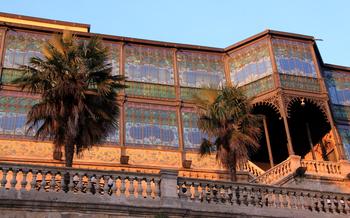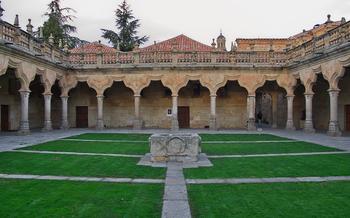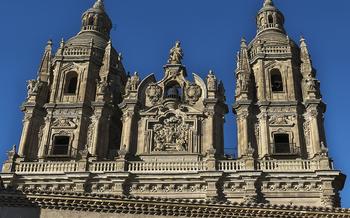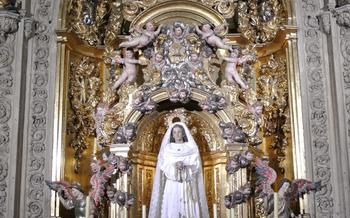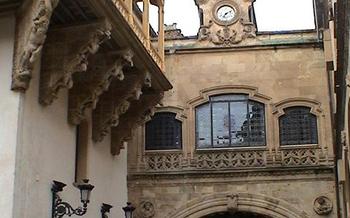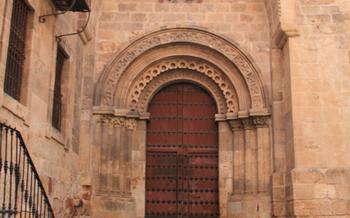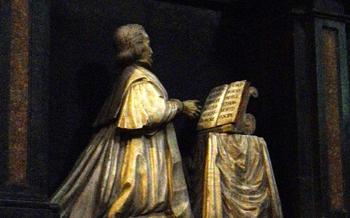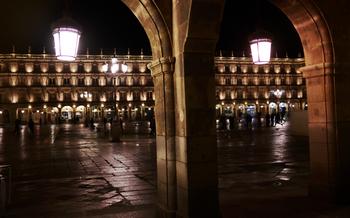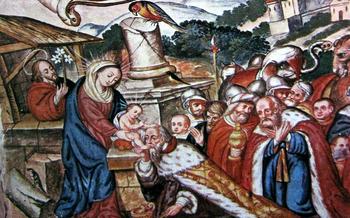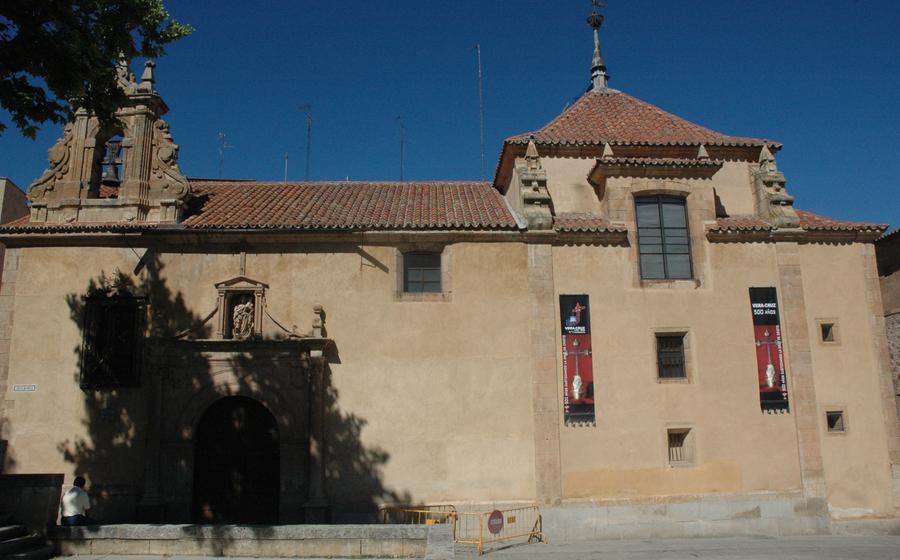
Capilla de la Santa Vera Cruz
- The Capilla de la Santa Vera Cruz, Salamanca: A Historical and Cultural Gem
- The Brotherhood of the Vera Cruz: Keepers of Tradition
- The Passion Façade: A Masterpiece of Plateresque Art
- Interior Highlights: Discover the Hidden Treasures
- Holy Week Processions: A Time of Reverence and Spectacle
- The Legend of the True Cross: A Sacred Relic
- Guided Tours: Unveiling the Chapel's Secrets
- Photography and Videography: Capturing the Essence
- Accessibility and Visitor Facilities
- Souvenirs and Devotional Items: Mementos of Faith
- Dress Code and Etiquette: Respecting the Sacred Space
- Location and Transportation: Getting There
- Nearby Attractions: Exploring Salamanca's Treasures
- Local Cuisine and Dining Options: Savoring Salamanca's Flavors
- Insider Tip: Hidden Details and Secrets
The Capilla de la Santa Vera Cruz, Salamanca: A Historical and Cultural Gem
In the heart of Salamanca, Spain, stands the Capilla de la Santa Vera Cruz, a captivating historical and cultural gem waiting to be explored. Founded in the 15th century, this chapel has long been a symbol of religious devotion, artistic mastery, and community spirit. Its stunning Plateresque façade, intricate interior, and profound significance in the city's traditions make it a must-visit destination for pilgrims, art enthusiasts, and curious travelers alike.
Visiting the Capilla de la Santa Vera Cruz is a journey through time, immersing you in the rich history and traditions of Salamanca. As you step inside, the chapel's serene atmosphere envelops you, inviting you to contemplate its sacred beauty and its profound influence on the city's religious and cultural life. The chapel is open to the public, offering visitors the opportunity to marvel at its architectural wonders, discover its hidden treasures, and experience the vibrant traditions that have been carefully preserved for centuries.
The Brotherhood of the Vera Cruz: Keepers of Tradition
The origins of the Brotherhood of the Vera Cruz date back to the 15th century, when a group of devout Catholics came together to venerate the True Cross, a relic believed to contain a fragment of the cross on which Jesus Christ was crucified. Over the centuries, the brotherhood has grown in size and prominence, becoming one of the most influential religious organizations in Salamanca.
The brotherhood plays a crucial role in preserving and perpetuating the city's rich religious traditions, particularly during the Holy Week processions. Its members, known as "cofrades," are responsible for organizing and carrying the elaborate floats that depict scenes from the Passion of Christ. They also wear distinctive robes and hoods, adding to the solemnity and spectacle of the processions.
In addition to its role in Holy Week, the brotherhood engages in various charitable and social works throughout the year. It provides assistance to the needy, supports educational and cultural initiatives, and promotes interfaith dialogue. Through these activities, the brotherhood demonstrates its commitment to serving the community and upholding the values of compassion, solidarity, and faith.
The Passion Façade: A Masterpiece of Plateresque Art
The Capilla de la Santa Vera Cruz boasts an exceptionally ornate and intricate façade, showcasing the remarkable style of Plateresque architecture. This elaborate frontispiece is a testament to the skill and artistry of the renowned sculptors and artisans who meticulously crafted each element.
The façade is adorned with intricate carvings and decorative motifs, reminiscent of the delicate work of silversmiths, hence the term "Plateresque." Its name derives from the Spanish word "plata," meaning silver. The intricate details and abundance of ornamentation create a visually captivating effect, transforming the chapel's exterior into a true work of art.
The façade features a central doorway flanked by two arched niches, each housing a sculpture of a saint. Above the doorway, an exquisite tympanum depicts the scene of the Entombment of Christ, surrounded by intricately carved figures. The upper section of the façade is adorned with a gallery of small arches, each containing a delicate sculpture of a biblical character or a religious symbol.
The passion façade of the Capilla de la Santa Vera Cruz stands as a prime example of the Plateresque style in Spain, comparable to other notable facades such as the west façade of the University of Salamanca and the façade of the Colegio de San Gregorio in Valladolid. Each of these architectural masterpieces exhibits unique variations of the Plateresque style, showcasing the diverse interpretations of this intricate and highly decorative artistic movement.
Interior Highlights: Discover the Hidden Treasures
Stepping inside the Capilla de la Santa Vera Cruz is like entering a sacred art gallery. The interior is a treasure trove of religious masterpieces, each telling a story from the Bible or the history of the brotherhood.
The main altarpiece, a stunning example of Renaissance craftsmanship, dominates the chapel's interior. Its intricate carvings depict scenes from the life of Christ, from his birth to his resurrection, with meticulous attention to detail. Each figure, each gesture, seems to come alive, inviting visitors to contemplate the mysteries of faith.
The stained glass windows, with their vibrant colors and intricate designs, bathe the chapel in a celestial glow. They depict biblical narratives, saints, and symbols, adding to the chapel's spiritual atmosphere. The play of light through the stained glass creates a kaleidoscope of colors, transforming the interior into a sacred sanctuary.
Murals and frescoes adorn the walls of the chapel, adding another layer of visual storytelling. These artworks portray scenes from the Bible, the lives of saints, and the history of the brotherhood. The vivid colors and expressive brushstrokes bring the stories to life, immersing visitors in the rich tapestry of Christian tradition.
Among the many treasures on display, visitors can find unique relics and artifacts that hold great significance for the brotherhood and the faithful. These include fragments of the True Cross, revered as one of the most sacred relics in Christianity, and other relics associated with the saints and martyrs of the Catholic Church. These relics serve as tangible reminders of the deep faith and devotion that have been nurtured within these walls for centuries.
Holy Week Processions: A Time of Reverence and Spectacle
During Holy Week, the Capilla de la Santa Vera Cruz takes center stage in Salamanca's religious celebrations. The brotherhood organizes and participates in elaborate processions that fill the streets with solemnity and spectacle. These processions, known as "procesiones," are a testament to the deep-rooted faith and traditions of the city.
The processions feature intricately decorated floats adorned with religious imagery, carried by members of the brotherhood. Participants wear elaborate costumes, some representing biblical figures, while others carry candles or religious objects. The atmosphere is one of reverence and devotion, as thousands of people line the streets to witness the processions and pay homage to the sacred relics.
The highlight of the Holy Week processions is the "Procesión del Santo Entierro," held on Good Friday. This procession, which commemorates the burial of Jesus, features the most impressive floats and the largest number of participants. The streets are illuminated by flickering torches, creating a haunting and evocative atmosphere.
As the processions make their way through the city, the air is filled with the sound of drums, trumpets, and the chanting of prayers. The emotions are palpable, as participants and spectators alike are deeply moved by the religious significance of the occasion. These processions are not just a spectacle but a powerful expression of faith and a reminder of the enduring traditions of Salamanca.
The Legend of the True Cross: A Sacred Relic
The Capilla de la Santa Vera Cruz is home to a revered relic of immense religious significance: a fragment of the True Cross, on which Jesus Christ is believed to have been crucified. According to legend, the relic was acquired by the brotherhood under extraordinary circumstances. In the 13th century, a pious knight named Pedro Maldonado embarked on a pilgrimage to the Holy Land. During his journey, he encountered a group of Muslim merchants who possessed a fragment of the True Cross. Deeply moved by its sanctity, Maldonado negotiated its purchase and brought it back to Salamanca. Upon his return, the relic was solemnly enshrined within the Capilla de la Santa Vera Cruz, where it has remained ever since.
The True Cross relic is not only a symbol of Christ's sacrifice but also a source of veneration and devotion for the faithful. Pilgrims and visitors from around the world flock to the chapel to pay homage to this sacred artifact. Every year, during Holy Week, the relic is carried in a grand procession through the streets of Salamanca, drawing thousands of spectators who witness this solemn display of faith and devotion.
Guided Tours: Unveiling the Chapel's Secrets
Delve deeper into the captivating history, architecture, and religious significance of the Capilla de la Santa Vera Cruz by joining a guided tour. Led by knowledgeable and passionate guides, these tours offer an immersive and educational experience that brings the chapel to life.
Choose from a variety of tours tailored to different interests and preferences. English-speaking tours are available for international visitors, ensuring that everyone can appreciate the chapel's grandeur and symbolism.
During the tour, you'll gain exclusive access to restricted areas or hidden spaces not accessible to the general public. Discover secret chambers, admire hidden artworks, and uncover intriguing stories behind the chapel's construction and restoration.
Booking a guided tour is highly recommended, especially during peak tourist season, to avoid long lines and ensure a personalized experience. Advance reservations can be made online or through the chapel's official website.
Whether you're a history buff, an art enthusiast, or simply seeking a deeper connection to the spiritual essence of the chapel, a guided tour will undoubtedly enhance your visit and leave you with lasting memories.
Photography and Videography: Capturing the Essence
The Capilla de la Santa Vera Cruz is a visual feast, inviting photographers and videographers to capture its stunning beauty. While respecting the religious atmosphere, visitors are welcome to document their experience through photography and videography. To ensure the best results, consider these tips:
-
Lighting: The chapel's interior is dimly lit, creating a dramatic ambiance. Use natural light from the stained glass windows for a warm, ethereal glow. Tripods are allowed, enabling you to stabilize your camera for crisp shots.
-
Composition: Experiment with different angles to showcase the chapel's grandeur. Capture the intricate details of the altarpiece, the vibrant colors of the stained glass, and the emotive expressions of the sculptures.
-
Respect: Remember that the chapel is an active place of worship. Be mindful of ongoing religious services and avoid disrupting the serene atmosphere. Silence your camera and flash, and move discreetly around the chapel.
-
Post-Processing: Take advantage of post-processing techniques to enhance your photos and videos. Adjust lighting, color, and contrast to bring out the richness and depth of the chapel's interior.
Accessibility and Visitor Facilities
The Capilla de la Santa Vera Cruz is committed to providing an inclusive and welcoming environment for all visitors. Accessibility features have been implemented to ensure that everyone can enjoy the chapel's beauty and history.
Wheelchair users and visitors with limited mobility can easily access the chapel through a dedicated ramp. Once inside, the ground floor is fully accessible, allowing visitors to explore the main chapel space, admire the altarpiece, and view the stained glass windows.
Guided tours in sign language or with audio description are available for visitors with hearing or visual impairments. These tours provide a comprehensive overview of the chapel's history, architecture, and religious significance.
Restrooms, cloakrooms, and drinking water facilities are available for the convenience of visitors. Families with young children can find designated areas within the chapel where they can rest and attend to their children's needs.
With its thoughtful amenities and inclusive approach, the Capilla de la Santa Vera Cruz ensures that all visitors can have a meaningful and enriching experience.
Souvenirs and Devotional Items: Mementos of Faith
A visit to the Capilla de la Santa Vera Cruz offers an opportunity to acquire meaningful souvenirs and devotional items that serve as reminders of this sacred place. The official merchandise store within the chapel sells a range of items, including postcards, books, and replicas of the chapel's artwork. For those seeking religious items, there are rosaries, crucifixes, and medals, each imbued with spiritual significance.
Beyond the official store, the surrounding area offers a treasure trove of unique keepsakes. Local artisans craft intricate pottery, jewelry, and textiles inspired by the chapel's architecture and symbolism. These handmade souvenirs provide a tangible connection to the city's rich cultural heritage.
When selecting souvenirs, remember to prioritize quality and authenticity. Look for items that are locally made and reflect the essence of Salamanca. Whether you choose a delicate piece of jewelry, a hand-painted ceramic tile, or a beautifully illustrated book, your souvenir will serve as a cherished memento of your visit to this extraordinary chapel.
Dress Code and Etiquette: Respecting the Sacred Space
When visiting the Capilla de la Santa Vera Cruz, it is crucial to adhere to a respectful and appropriate dress code. As a sacred religious site, the chapel demands a level of decorum and reverence from visitors. While there is no strict dress code, modest attire that covers the shoulders and knees is generally recommended. Avoid wearing shorts, tank tops, or revealing clothing that may be deemed disrespectful in a religious setting.
Beyond attire, maintaining appropriate behavior and conduct within the chapel is essential. Visitors are expected to be mindful of the solemn atmosphere and refrain from disruptive activities. Silence should be observed as a sign of respect for the sanctity of the space and the ongoing religious practices. Photography and videography are permitted, but using flash or making excessive noise should be avoided.
It is vital to respect the privacy of others and avoid engaging in conversations or activities that may disturb the peaceful ambiance of the chapel. Visitors are encouraged to be considerate of the religious significance of the site and behave in a manner that reflects respect and understanding. By following these guidelines, visitors can contribute to preserving the sacred nature of the Capilla de la Santa Vera Cruz and ensure a meaningful experience for all.
Location and Transportation: Getting There
The Capilla de la Santa Vera Cruz is conveniently located in the heart of Salamanca's historic center, a UNESCO World Heritage Site. Its exact address is Calle Zamora, 1Reaching the chapel is a breeze, whether you prefer to walk, take public transportation, or drive.
For those who enjoy leisurely strolls, the chapel is just a short walk from the Plaza Mayor, the city's main square. Simply head east along Calle Toro and turn right onto Calle Zamora. The chapel will be on your left, just a few steps away.
If you prefer public transportation, several bus lines stop within a short walking distance of the chapel. Lines 1, 2, 5, 6, 8, 10, and 11 all have stops nearby, making it easy to get there from anywhere in the city.
For those arriving by car, there are several parking options in the vicinity of the chapel. The closest parking garage is the Parking Catedral, located just a few blocks away on Calle San Justo. Street parking is also available in the surrounding streets, but it can be limited during peak tourist season.
Nearby Attractions: Exploring Salamanca's Treasures
The Capilla de la Santa Vera Cruz is nestled in the heart of Salamanca's historic center, surrounded by a wealth of cultural and historical attractions. Just steps away, you can marvel at the awe-inspiring Catedral Nueva, with its Gothic spires piercing the sky. Admire the ornate façade of the Universidad de Salamanca, a UNESCO World Heritage Site and one of the oldest universities in Europe.
For art enthusiasts, the Museo de Art Nouveau y Art Déco offers a captivating collection of decorative arts from the late 19th and early 20th centuries. History buffs can delve into the city's past at the Museo de Historia de Salamanca, housed in a former palace.
Strolling along the narrow cobbled streets, you'll discover hidden plazas, charming boutiques, and inviting cafés. The Plaza Mayor, the city's main square, is a vibrant hub of activity, lined with lively bars and restaurants.
To experience the local market atmosphere, head to the Mercado Central, where you can browse stalls selling fresh produce, local delicacies, and handmade crafts.
Whether you're interested in history, art, shopping, or gastronomy, Salamanca offers a treasure trove of experiences to complement your visit to the Capilla de la Santa Vera Cruz.
Local Cuisine and Dining Options: Savoring Salamanca's Flavors
Salamanca's culinary scene is as rich and diverse as its history and culture. While visiting the Capilla de la Santa Vera Cruz, take the opportunity to explore the city's gastronomic delights.
Indulge in traditional dishes such as the hearty "cocido salmantino," a stew made with chickpeas, pork, beef, chorizo, and vegetables, or the "chanfaina," a mix of rice, pork, lamb, and spices. For a taste of local street food, try the "hornazo," a savory pastry filled with sausage, eggs, and pork loin.
For a memorable dining experience, visit one of the many restaurants near the chapel. "El Mesón de Gonzalo" offers a traditional setting and classic Spanish cuisine, while "La Fonda del Arcediano" serves innovative dishes with a modern twist. For a casual meal, try the "Bar Restaurante La Vera Cruz," which offers a variety of tapas and local specialties.
To fully immerse yourself in the city's culinary culture, explore the vibrant markets, such as the Mercado Central, where you can find fresh produce, local cheeses, and cured meats. Don't miss the opportunity to sample the region's renowned wines, such as the "Denominación de Origen" wines from the nearby Sierra de Francia.
Remember to savor the flavors of Salamanca, as they are an integral part of the city's charm and heritage.
Insider Tip: Hidden Details and Secrets
Overlooked Architectural Marvels: Look closely at the intricate carvings on the façade and interior walls. You might spot hidden faces, animals, or symbols that hold special meaning.
Secret Passageways: There are rumors of secret passageways leading from the chapel to other parts of the city. Keep your eyes peeled for hidden doors or staircases.
Whispers of the Past: Listen carefully to the echoes within the chapel. Some say you can hear whispers of prayers and chants from centuries ago.
Hidden Altar: Behind the main altarpiece, there's a hidden altar with a stunning fresco that's rarely seen by visitors. Ask a guide or staff member for permission to view it.
Legends of the Brotherhood: The brotherhood has many fascinating and mysterious stories passed down through generations. Ask a local guide to share some of these tales.
Remember, these insider tips are just a taste of the hidden treasures waiting to be discovered at the Capilla de la Santa Vera Cruz. Keep your eyes open, engage with the locals, and let the magic of the chapel reveal itself to you.
